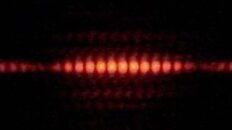TRANSCRIPTS:
This is a photon. Or at least, it’s a visual representation of a photon.
And this is a slit in a piece of paper. Two of them, actually.
And this is the famous double slit experiment. I’m sure most of you know what happens next, if nobody is looking, photons will arrange themselves on the back wall in a waveform pattern, indicating that they traveled through the slits in a superposition of states.
And if you add a sensor to one of the slits to try to determine which slit it goes through, the pattern on the back wall becomes two groupings, indicating that the photons traveled through the slit as a particle.
If you’re somehow not familiar with the double-slit experiment, I’ve got a video on it, you can go check it out for context but long story short, when the particle is observed, its superposition collapses down to a particle state. It’s one of the weirdest things in quantum mechanics.
And often when scientists and science communicators describe what happens here, they say things like, “it chooses which slit to go through” or it “reacts to an observation.” This is a massive oversimplification of what happens but it gets the idea across.
It’s like when people say that evolution chose to change an animal in some way to adapt to their environment, obviously there is no being called evolution making a choice here, it’s just a manner of speech.
But some scientists and philosophers are starting to consider… what if that’s exactly what’s happening? What if that photon or particle is making an actual conscious choice? Because everything is conscious?
he double slit experiment is a good example of matter acting weird at the tiniest scales, but there are weird things happening at the biggest scales too.
Take dark matter and dark energy.
The Invisible Universe
This is Pandora’s Cluster. The lights you see are stars and galaxies from at least four different galaxy clusters. The whole mess collided sometime in the distant past.
Here’s a composite shot including X-ray information in red and the total mass concentration in blue. Notice all that blue mass where there’s no optical light? That’s dark matter. In fact 75% of the mass of Pandora’s Cluster is dark matter.
It’s thought that dark matter makes up 27% of all the mass in the universe. And most of the rest of the universe is dark energy.
Nobody knows what dark matter is. Same goes for dark energy. So, in a real sense, 95% of what SHOULD appear in our telescopes is a mystery.
So there are huge mysteries at the smallest and largest scales. It would be nice if these all the mysteries had something in common, like if there was an effect that could explain everything. But we can’t seem to find it. I mean, if the universe were a person, I’d kind of think it was messing with us.
Maybe it is!
Universal Consciousness
One theory that attempts to explain the unexplainable in science is panpsychism. The basic idea is as simple as it controversial. Everything is conscious. Like… everything.
Galaxy clusters? Conscious. Fundamental particles? Conscious. A guy in a coma? Complicated, but all the cells in his body and all the molecules in those cells are, in some way, conscious.
The appeal of panpsychism is its ability to explain mysteries as choice. Maybe dark matter and dark energy don’t exist. We only think they do because the stars and galaxies choose to act a certain way.
Same for fundamental particles. Maybe quarks, electrons, and photons aren’t that mysterious at all, because they make actual choices.
Yeah, I know, just hang with me for a second.
On the Fringe
I touched on panpsychism before, in my video on the General Resonance Theory of Consciousness.
Tam Hunt, the co-author of GRT, offered a definition of “consciousness” in a recent paper that helps demystify panpsychism a little bit.
Consciousness Defined
According to Tam, consciousness refers to “the capacity for phenomenal/subjective experience”. In this context, phenomenal means something that is sensed, and subjective implies a point-of-view. So, we say a thing is conscious if it can perceive from its point-of-view.
I can perceive lots of things. Sights, sounds, smells. Which… I swear one of the dogs peed in here. (made a choice to pee in here bit)
Obviously, fundamental particles don’t perceive as I do. But they do have properties, like electric charge, that are acted on by their environment. Electrons are attracted to positively charged particles and repelled by particles with a negative charge.
That attraction could be seen as perception. The fact attraction varies with distance suggests electrons have a point of view. You can say the same about every object that has properties and interacts.
This even applies to theoretical objects, like magnetic monopoles, and string theory’s strings.
General Resonance Theory
So how do we go from perception and POV to consciousness like you or I have? Different theories have different ideas. I’ve already mentioned my video on resonance, but here’s a quick review.
In the General Resonance Theory of Consciousness, objects that vibrate in a synchronized way develop a “shared resonance”. This allows them to combine their consciousness perception.
More complex consciousness, like our own, results from many smaller, simpler consciousnesses resonating together. Sort-of an emergence theory.
Integrated Information Theory
A somewhat similar theory is IIT, the Integrated Information Theory, developed by Giulio Tononi. This theory doesn’t go all the way down to fundamental particles like General Resonance Theory, but it does speak to how the elements in a system communicate to create consciousness.
It also proposes a measurement of consciousness, called phi. Actually, what phi measures is the “integrated information” of the theory’s name.
Color and shape are one example of integrated information. Our eyes don’t see “red” or “round”. They see red wavelengths of light and depth cues that tell us the red thing curves away.
Redness and roundness are concepts the brain has to combine, or integrate, to show us a red balloon.
In IIT, integration is physical. Our neurons do it by exchanging neurotransmitters.
Can AI be Conscious?
The human brain is structured to do a lot of parallel processing. Our perception of a red balloon is processed in several parts of the brain simultaneously, with all those parts communicating with each other.
Most computers can’t do this because of the structure of the processing units. Which implies that as smart as these AIs are getting, they can never achieve humanlike consciousness.
That is, if they’re running on normal computers. But neuromorphic computers, computers designed like a human brain, can. Maybe.
There have been recent attempts to create neuromorphic computers. DARPA funded a project named SyNAPSE about ten years back. IBM uses neuromorphic chips in its Summit supercomputer.
By the way, Summit is being used to research atomic fusion. So maybe we’ll get artificial consciousness and fusion energy at the same time. That’ll be a fun news cycle.
Seriously, neuromorphic computers are a deep topic. A lot deeper than I can go into here. The short version is, they stand a lot better chance of developing a consciousness like ours than your typical, scaled-up Dell.
Penrose and Microtubles
Anyway, GRT and IIT are the tip of the iceberg when it comes to panpsychism. There are theories out there about the role vacuum energy and quantum fluctuations play in consciousness. Roger Penrose was all about that last one.
And if that’s the case, they could also be entangled. And those entangled particles could allow for some emergent effects.
Only Biological?
There’s some debate as to whether or not Penrose believed consciousness exists outside biological organisms and across the universe. The most confident statement we can make is, he didn’t rule it out.
But back to the question of whether everything in the universe is conscious. Including the food you eat. Let’s not think about that too much.
It needs to be said that most panpsycists are philosophers, so… (look at the woo woo alarm)
To be fair, there are physicists, astronomers, and neurologists that approach it from different angles.
One of those physicist-astronomer types is a former NASA consultant named Gregory Matloff.
Volitional Stars
Dr Matloff came to panpsychism through the work of Olaf Stapledon.
Olaf Stapledon is a fiction writer, and if you haven’t heard of him, well maybe you should have. Freeman Dyson said the Dyson sphere should be called a Stapledon sphere, because it was his book Star Maker that gave him the idea.
The same book describes a universal consciousness made up of linked minds.
Dr Matloff was intrigued, so he looked for a way to test if astronomical objects could be conscious.
In his 2016 essay “Can Panpsychism Become an Observational Science?” he points to observational data “that cool, less massive stars circle the galaxy’s center a bit faster than hot, massive stars.”
The other is unipolar stellar material jets. This is where material spirals in to a massive object like a black hole or a star and it fires it out at the poles. This usually goes in both directions but if it went in just one, it could move the star slowly over time.
Last but not least, Matloff suggests psychokinesis may be doing it. Like, you know… psychokinesis.
He admits this is controversial. But if panpsychism is a thing – and psychokinesis is a thing – it wouldn’t take much to change a star’s velocity over the course of a billion years.
Like he suggested it would require about the same level of consciousness as developing embryonic cells.
Okay, it’s time.
So look, are we doing science here or what? Because if we’re doing science we have to be able to test this.
Measurable Correlates of Consciousness
And there are people working on that. In a recent paper, the authors discussed ways to measure consciousness, and they proposed MCCs or Measurable Correlates of Consciousness.
And there are several subcategories of MCCs, the main ones being BCCs – Behavioral Correlates of Consciousness, NCCs, or Neural Correlates of Consciousness, and CCC, Creative Correlates of Consciousness.
They argue that the existence of any or all the above suggests the subject is conscious.
It’s the Neural Correlates that have gotten the most attention. In fact one of the researchers who was doing early NCC work back in the 90s was Francis Crick, the DNA guy.
Crick worked with another well-known scientist, Christof Koch, he’s a neurophysiologist who has embraced IIT as the best current theory of consciousness. He’s also embraced vegetarianism, because, you know, the meat might mind.
Yup, Crick and Koch.
But for example, they worked with the original IIT theorist Tononi to try to calculate the consciousness of a worm by considering all the different ways information could flow through the worm’s neurons.
This is hard enough. It would be next to impossible to do it for humans but they’re working on finding patterns in EEGs that could show different parts of the brain communicating.
Then there’s Behavioral Correlates of Consciousness, this obviously has to do with the behavior of things in physical space.
This could be everything from a cat purring when you pet it to a mosquito being drawn to carbon dioxide in the air. Maybe to photons in double slit experiments.
An interesting branch of this has been applied recently in terms of the behavior of AI, with several programs passing the Turing test in the last decade.
The last one I’ll talk about here is CCS: Creative Correlates of Consciousness. Does the subject in question have the capacity for creative expression.
Like it makes me think of the movie Cave of Forgotten Dreams that kind-of makes the argument that it was only when humans began painting on caves and recreating what they saw in the world that we truly became human. Which is an interesting thought to me.
Of course today, AI can recreate images too. Does that count? I think that’s an interesting question.
And there are more of these correlates but we have to be careful to be objective because we do have a tendency to anthropomorphize things, we tend to project ourselves onto the world. So we need to make sure that something is actually looking back at us, or we’re not just seeing our own reflection.
o look, this is definitely Woo Woo Alarm territory, especially when you get into the idea that stars are consciously moving themselves around. Which I think was in the plot of the Fifth Element?
On that level, panpsychism isn’t so much a theory of everything as it is something that fills the gaps in our current knowledge. One of many things we’ve come up with.
And talking about consciousness emerging from vibrational subatomic stuff gets into some pretty yikesy territory but who knows? As our come to better understand both consciousness and the fabric of spacetime, we might find some connections.
Besides if it did turn out we’re all just a part of a universal consciousness, it might help us feel more connected to each other. And that’s not a bad thing.




Add comment